Contact Us. Web site contents copyrighted. All rights reserved. Made With Serif WebPlus. Home

Board Corral Allotment Habitat Restoration and Fuels Reduction Project
BLM Surprise Field Station, Cedarville, California
Project Located in Washoe County, Nevada

The Board Corral juniper removal project is the first BLM juniper project for which we have been able to gather before and after data since we reported on the disastrous results by the BLM on the Home Camp Corral Allotment juniper project in 2014.
After the BLM cut down hundreds of old growth juniper on the Home Camp Corral Allotment we contacted the BLM district office in Redding, California. We asked BLM management to find out “... how and why what is said in BLM environmental documents is not strictly followed on the ground during project implementation”. Because of our inquiry and a BLM investigation, the BLM District Management imposed an “on hold” order on all juniper projects in the Alturas and Surprise Valley area until a review of NEPA documents occurred along with a follow up with District Management. This is the first on the ground opportunity we have had to verify whether a change in BLM implementation of juniper removal projects in the Alturas/Surprise area has occurred.
The Board Corral Allotment is located between the Sheldon National Antelope Refuge to the north and the Massacre Rim Wilderness Study Area to the south. The BLM proposed to remove young juniper on 472 acres.
In the Decision Record, DOI - BLM - CA - N070 - 2014 - 0019 - DR, under Mitigation Measures and Standard Operating Procedures, (SOP), we noted the following measures for this project and compared them with the Home Camp Corral Allotment SOP from 2012.
These two measures were found in both the Board Corral SOP and the Home Camp SOP:
1. “Preserve clumps of juniper scattered throughout the treatment area (estimated 5 - 10 trees per acre).”
2. “Individual old growth trees in restoration areas would be identified --- and preserved for their many social and ecological values.”
During the implementation of the Home Camp Corral juniper project the BLM left no groups of young juniper scattered throughout the project area and the BLM cut down hundreds of individual old juniper and destroyed old growth woodlands.
The following measures were found only in the Board Corral SOP: (these are new after our complaint to District BLM Management)
1. “Create openings in stands of trees that are irregular and natural in appearance.”
2. “BLM will provide project inspection at least once weekly during the implementation phase when contractors are completing project implementation.”
3. “Monitoring and data collection will follow Sage Steppe Ecosystem Restoration Strategy protocols and will be made available on the database for other agencies and the public.”
4. “In addition to preserving old growth trees, efforts would be made to maintain functioning ecosystems in historic juniper woodlands, especially those with a significant old growth component, --- soils data could be used to identify potential historic juniper woodlands, but on the ground verification of their presence would be completed before project implementation.”
5. “Within the project area and based on pretreatment monitoring data, there is estimated to be less than 25% old growth juniper.”
I. “In stands where more than 75% of trees exhibit old growth characteristics, no juniper will be cut.”
II. “In stands with 50 - 75% OGJ, up to 25% of young juniper may be removed.”
III. “In stands with 25 - 50% OGJ, up to 50% of young trees may be removed.”
It is apparent there has been a significant improvement in the written specifics regarding the treatment of old growth woodlands and individual old growth juniper by the BLM field offices in northeastern California. On the ground inspection of subsequent projects will determine whether the BLM follows through with the new SOP they have now written in their environmental documents.
We found many multi-stemmed old juniper on the Board Corral Allotment when we visited in 2013 before implementation of the juniper removal.
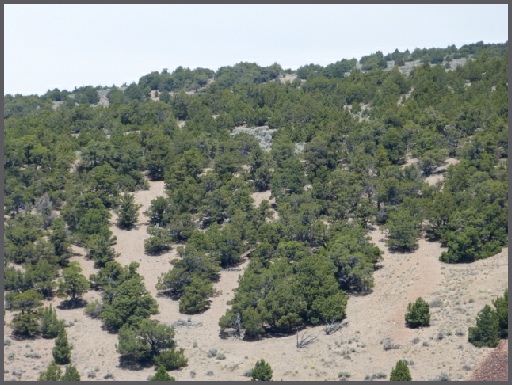
A typical old growth juniper woodland on the Board Corral Allotment in 2013. The project Decision Record estimated less than 25% of the juniper on this project were old juniper. In historic woodlands such as this the % of old juniper is 75% or more.
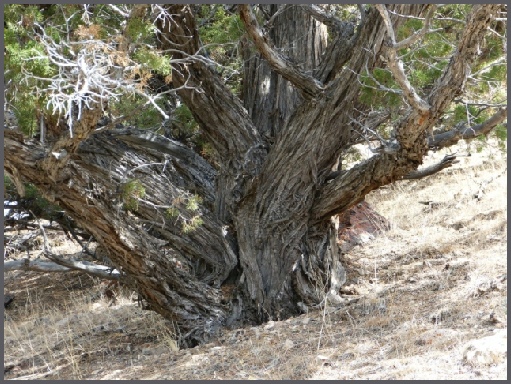
Most of the juniper on this project is Utah juniper or hybrid with Western juniper. The physical attributes of these juniper are quite different than Western juniper. Trees are usually shorter, more rounded, multi-trunked and with bark that varies. Consequently, as happened at Home Camp, BLM often cuts very old Utah juniper including unique old growth pygmy woodlands where the old trees were from 2 feet high to about 8 feet high.
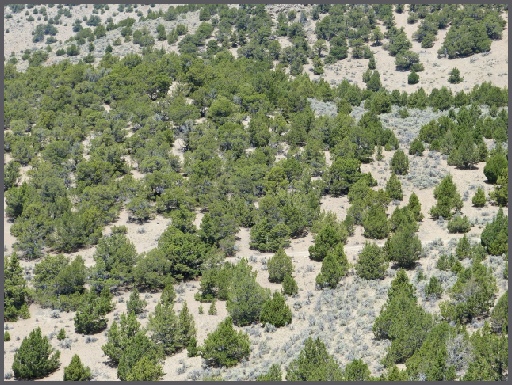
Habitat with areas of young juniper, lower and right in image, can benefit wildlife with thoughtful juniper removal following the new Standard Operating Procedures in the Board Corral proposal.
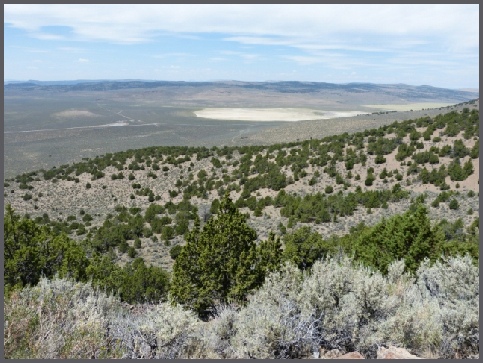
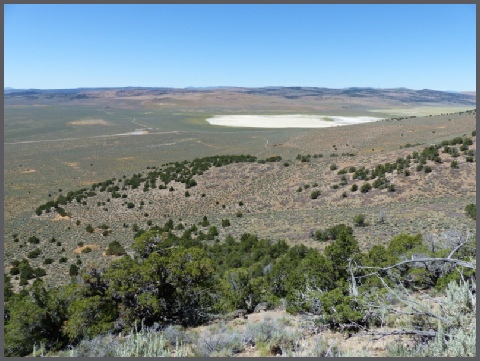

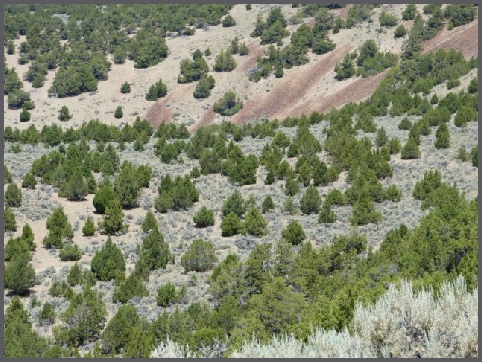
In both of these areas old growth juniper woodlands were left intact while young juniper was removed in drainage areas and within groups of old trees.
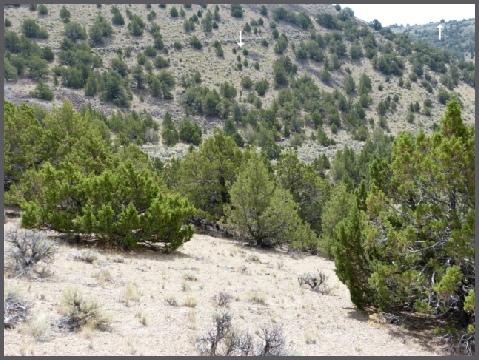
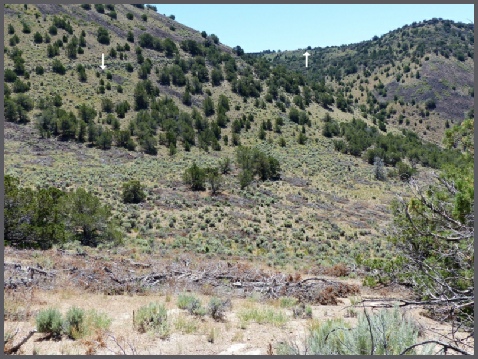
The arrows in these images point to the same trees that are in both before and after images. Young juniper was removed while groups of old juniper were left standing.
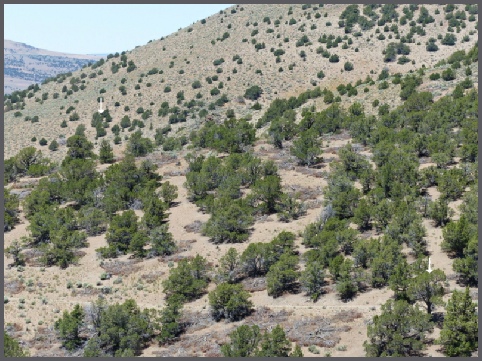
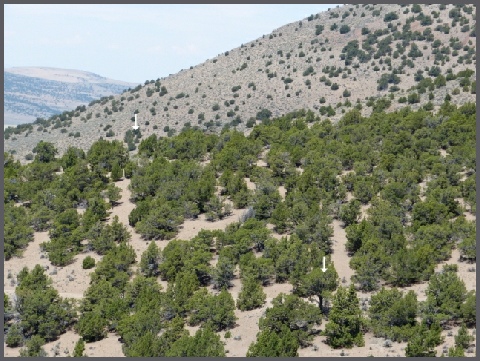
Pockets of young juniper were removed from this woodland that has a significant old growth component. The SOP said this was “...to mimic natural fire processes...”.
Compare this treatment with the Home Camp treatment of old growth woodlands.

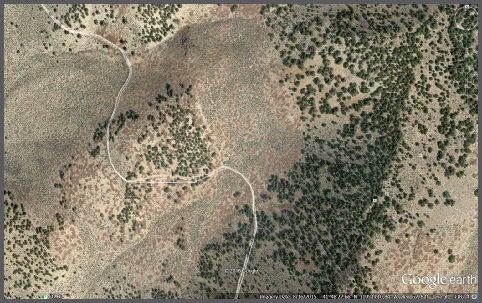
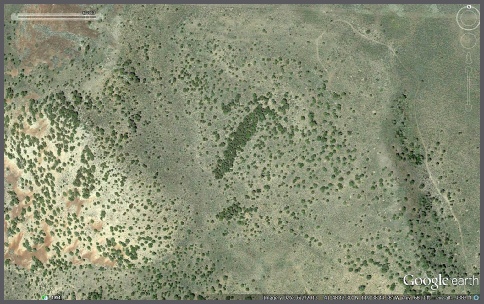
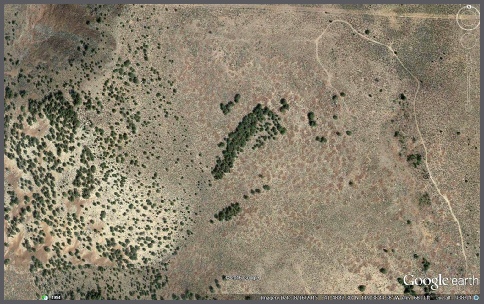
Below are before and after implementation images of the BML Board Corral Allotment juniper removal project. We took images of the project area in July of 2013 and then again in July of 2016 from approximately the same places. Left and right image pairs are of the same area of the project. The before satellite images are from June 2013 and the after satellite images are from August 2015. You may click on each image to see a larger image.
Before Images
After Images
These satellite images are of areas of the project that we could not reach. They clearly show that old juniper woodlands were left intact. Further, scattered groups of old trees and individual old growth juniper were left as well while young juniper was removed. The Sage Steppe Habitat Restoration Strategy, Final EIS, page 49, Section 2.4.4, April 2008, says that projects will be designed so that groups of “non-old growth” juniper will also be left so that cattle will tend to loaf under the young groups of juniper and stay away from the old growth trees. This is the basis for the SOP measure to “Preserve clumps of juniper scattered throughout the treatment area (estimated 5 - 10 trees per acre).” We have not found this done on a single juniper removal project yet. However the BLM has definitely made progress with the other measures from the new SOP.
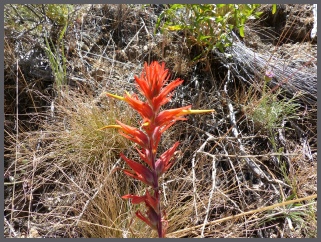
Our on the ground inspection of the recently completed Board Corral juniper project confirms that significant progress by the BLM has been made in following the written environmental documents for this specific project. In fact, this is the best all round result for a juniper project done by the BLM Surprise Field Station.
The Board Corral project at 472 acres is a very small part of the 500,000 acre Vya PMU Habitat Restoration and Fuels Reduction Project. However the Standard Operating Procedures for the Vya PMU are the same as for the Board Corral project. We are hoping the BML will continue to do on the ground what it says in its written project documents.